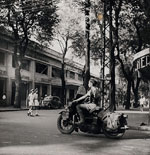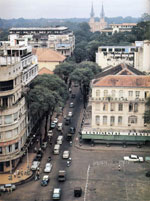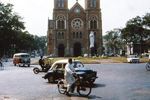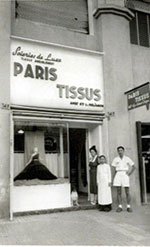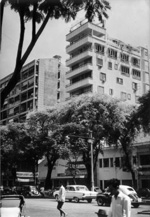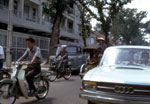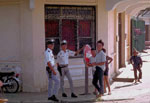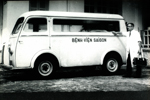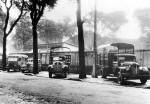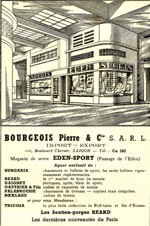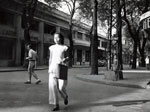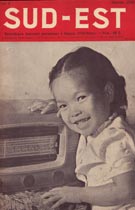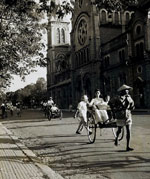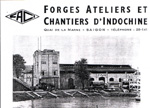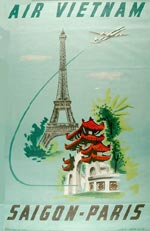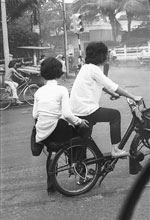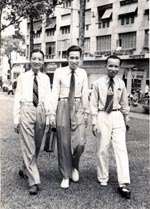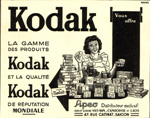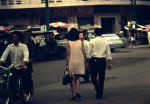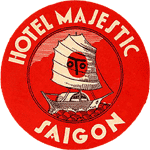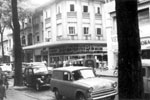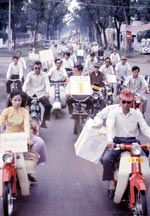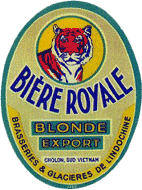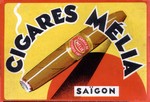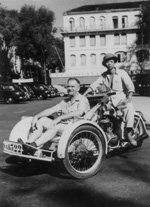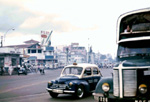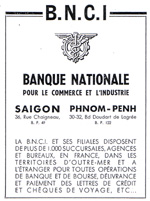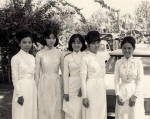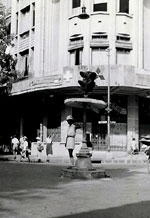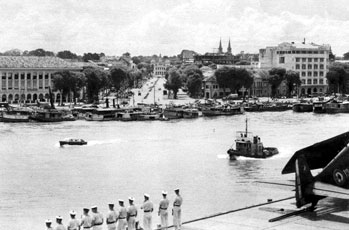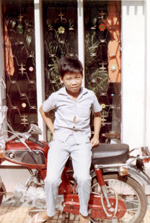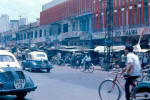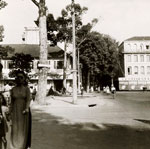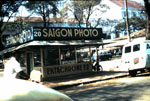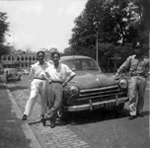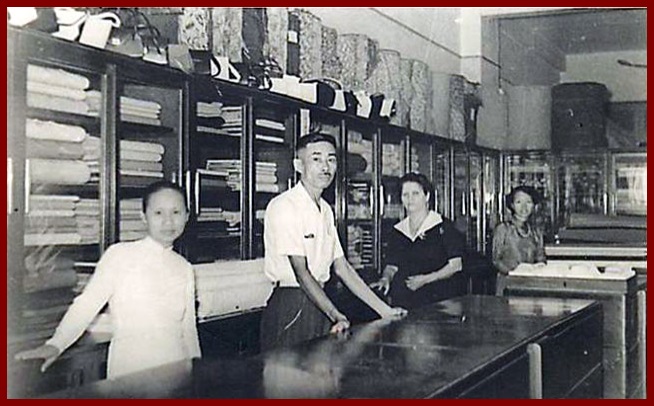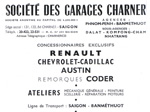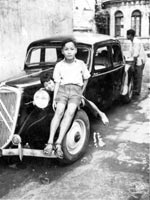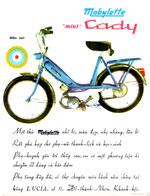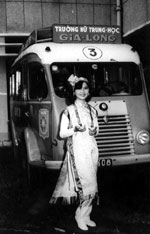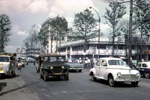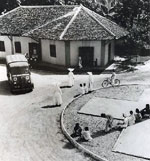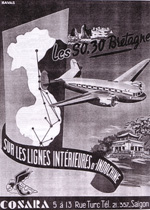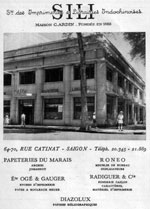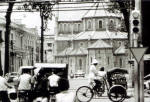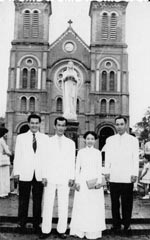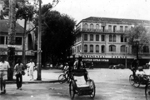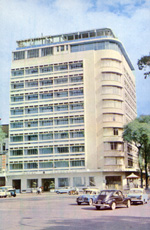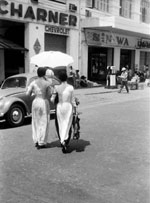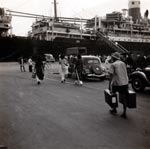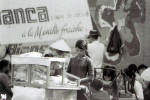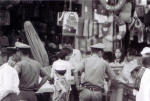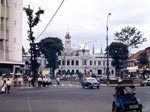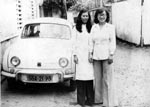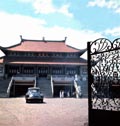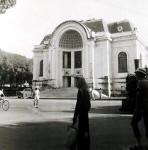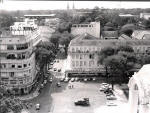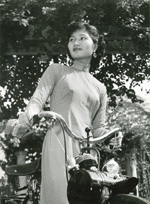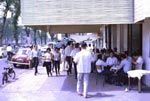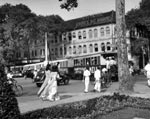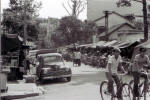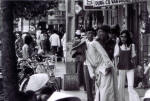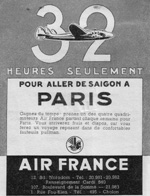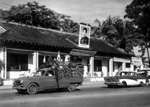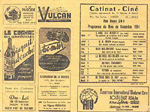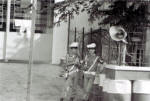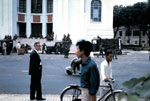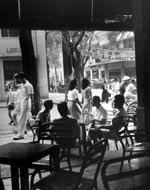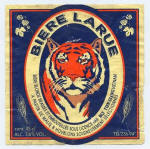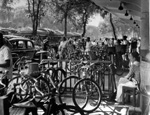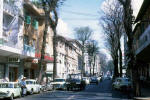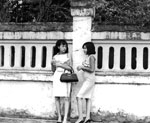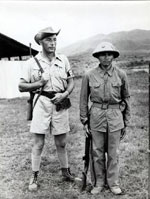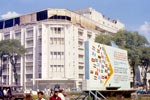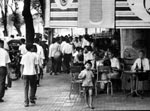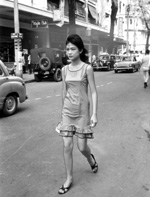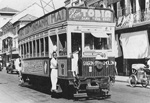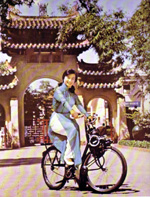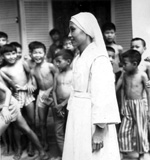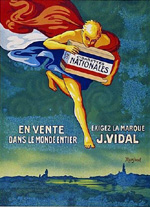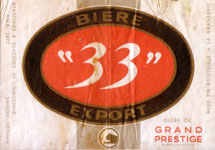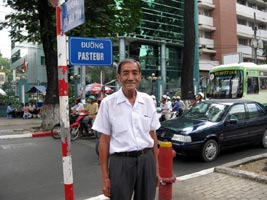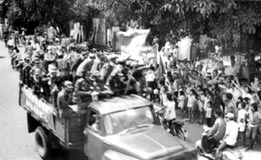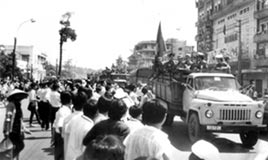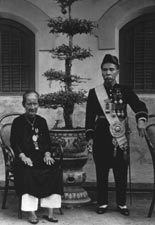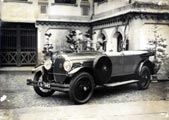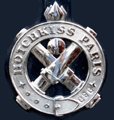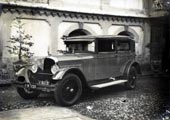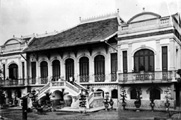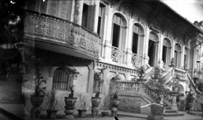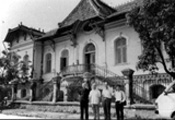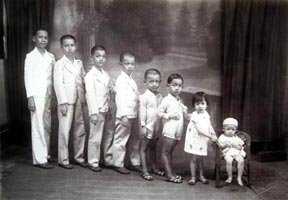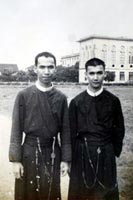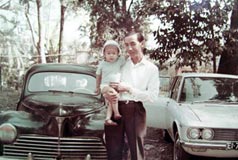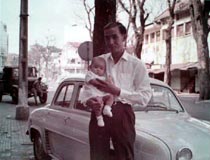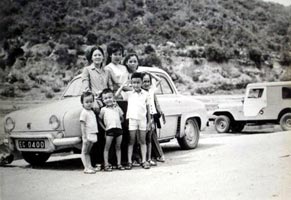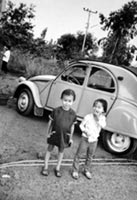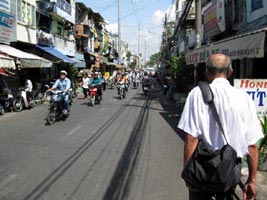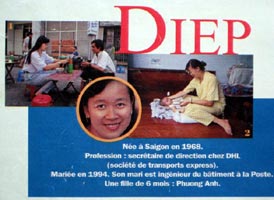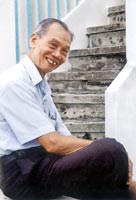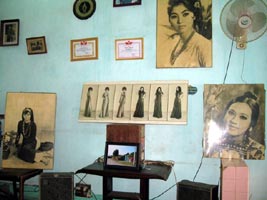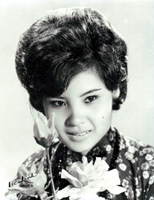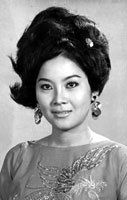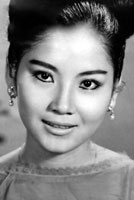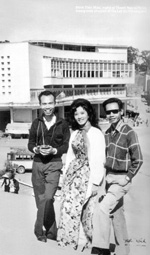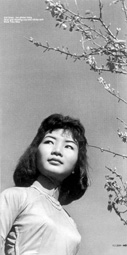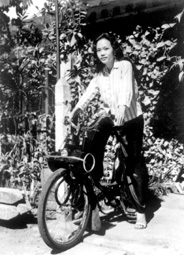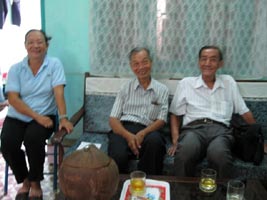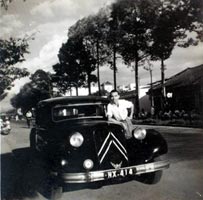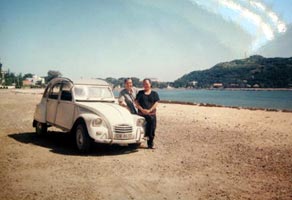
Portraits of Saigon residents :
Alphonse
in front of the Pasteur Street sign (formerly Pellerin St.)
April 30, 1975
The North-Vietnamese Army invades Saigon, while a panicked crowd tries desperately to get through the barbed wire of the American Embassy to board the helicopter which will take them away from the red hell.
Alphonse remembers this day which would forever leave its mark on his life. At the age of 77, this French-speaking Vietnamese Francophile prefers not to talk about these days of blood and tears. An information processing manager in a French bank before 1975, Alphonse lost everything with the arrival of the Communists.
The Communists confiscated his possessions, his home, and his land which had been in his family for generations. Considered to be an opponent of the communist regime, he was never able to find work again. His crime?, having spoken French and collaborating with this enemy whose culture and way of life he appreciated above all. But 34 years of communist purgatory weren’t able to erase his unconditional love of the French language.
This is why Alphonse prefers to think back to the happy memories of his childhood.
The grandparents of Alphonse in Vinhlong (Mekong delta)
Thérèse Tran Thi Ngan and Joseph Le Van Nuoi, the grandparents of Alphonse, at Vinhlong.
Le Van Nuoi’s grandparents’ cars, a 1925 Hotchkiss Torpedo and a Voisin, sold at the time by the Jean Comte Company in Saigon, they were the first cars to travel the roads of Cochin China.
The Vinhlong's house
A French childhood
I know the history of France better than I know that of Vietnam. Additionally, I spoke French better than Vietnamese. After the fall of Saigon, however, I stopped speaking the language of Molière, and now the words come to me with more difficulty”.
“The first book I read in French was The Life of Robinson Crusoe.
For me, France is the symbol of all the education I ever received. I would like for my grandchildren to get a French education, so that they would respect certain values, certain rules like the respect of others and the sense of responsibility for one’s actions.
Then the Japanese invaded us during the Second World War The allied forces, of which the French were a part, then came to disarm them. At that time, I became a young man. I changed my attitude toward the colonists. I started to weigh the pros and cons of their presence.
I make a clear distinction between the French, who brought us so many things, and the colonialists whose only goal was to exploit us.
They have no connection”.
In the photo on the left, Alphonse’s brothers and sister.
On the right, two of Alphonse’s brothers, as Redemptorist priests.
The family cars, a Peugeot 203 and a Renault Dauphine.
Alphonse certainly owes this profound attachment for France to the fact that he was born French.
“My father had requested to be naturalized French. This is why my twelve brothers and sister all have French given names. After 1975, I had to give up my French nationality. Since the politics of Doi Moi in 1986, I have begun proceedings to get it back again. Unfortunately all I’ve received so far are refusals. However my brothers and sister have lived there for nearly forty years. I was very disappointed”.
Nostalgic and holding no grudge, Alphonse has great admiration for all that the French left behind. He likes to wander along the traces of his youth while admiring the beauty of this architecture which has so fallen into disrepair over the years due to the construction of high-rises, particularly along the riverfront of the Saigon River and on Catinat Street.
Saigon, the Paris of the Far-East
« The French left us this admirable architecture. It is not without reason that Saigon was nicknamed the little Paris of the Far East. When one enters the cathedral, when on enters the City Hall, the Municipal Theater, or the Central Post Office, the metallic structure of which was built by Gustave Eiffel, one sees life differently. There is an incomparable grandeur which emanates from these buildings. When I was young we walked along the tree-lined avenues. The city was very green; there were many parks which, as of 1975, disappeared behind fences or concrete walls.
Often, after work, we would meet at Joker’s Point to chat. This place was turned into a restaurant and no one goes there any more because it’s much too expensive”.
In 2009 its existence was threatened by the construction of a bridge and a new tower!
Alphonse sighs. But he never complains. He never looks back to the time his wife and son died the same year from lack of care and medication. Philosophically, he does not look back upon his past but leans toward his life of today.
“I do not regret having lived what I’ve lived, because I think that no book in the world could have taught me what I have learned in 77 years of life. Nevertheless, I do regret one thing and that is never having seen Paris… and its Eiffel Tower”.
TText written by Barbara Castello for the magazine :

Gigi Diep, Alphonse’s daughter
Third floor of a French Colonial apartment building
In these former offices remodeled into collective apartments, Diep enjoys her last days of maternity leave. Sitting cross-legged on a bed made of painted wood, this young woman of 28 years rocks her 6 month-old daughter. A former professional volleyball player, she does not fit the expected image of the Vietnamese woman. From the top of her 6-ft frame she says aloud what others hardly dare whisper.
“I did not watch the parade organized by the government. For the people of Saigon, April 30th 1975 is no festive holiday. At the time, I was 7 years old. I remember well the arrival of North-Vietnamese troops in Saigon. My father was in the hospital. He was watching over my brother who was gravely ill. There were “BoDoi” (Vietnamese Army soldiers) everywhere. We did not know what was going to happen”.
PThen, very quickly, everything changed.
“We were a happy and close-knit family. After 1975 we lost everything. Our lands, our home in the Mekong Delta, our money, and our freedom… My mother and my little brother died from lack of medicine. Ho Chi Minh said: “There is nothing more beautiful than liberty and independence”. But the people of Saigon added: “There is nothing worse than independence without liberty”.
“In high school we were always very careful about what we said under penalty of being accused of having counter-revolutionary thoughts. The walls had ears... It was because of my size that I was selected to be on the national volleyball team. Then, after four years, I was sent to work in Pharmaceutical Laboratory No. 25. I had no choice, that was it. Every one had to have a manual job”.
“Since the Politics of Renewal, in 1986 Vietnam slowly opened up to the World. The Party is less present. There is no more curfew. One can dine with foreigners without being brought in by the police. That was unimaginable a few years ago”.
![]()
In 1989, Diep heard that the government was recruiting by contest for a job with DHL.
“I knew that working for a foreign company was a passport to the future. I studied for the test with the energy of despair. I studied day and night. Unfortunately, I had no recommendation and was sure that I would never make it. However, I speak perfect French and have command of English. When I heard that I got the job I couldn’t believe it”.
Aware that she wouldn’t get a second chance, Diep works hard at her new job and puts her private life on hold. Five years later, with her professional situation stabilized, she decides to have a child.
Today, Diep wishes above all to dedicate herself to her family.
“In Vietnam, the woman is above all a wife and mother. They say here that women are the “Home Generals”. Since I got married, I handle the books. When my husband needs money, he asks me for it.
It’s a measure of security for women. Isn’t it he who has the money has the power?
Since the lifting of the American embargo, Saigon lives by the dollar standard. Cell phones, shiny Mercedes’ among rickshaws and beggars. Everything changes far too quickly, and Diep doesn’t want to miss the start of this marathon.
Article published in the magazine :

The story of a person who has lived Life:
Mau, the photographer of Vietnamese celebrities.
The ViĂŞn Kinh Studio
"The Harcourt Studio of Saigon"
At the age of 76 years, every day he takes his wife on his Honda moped to go from the 3rd district of Ho Chi Minh City to Long An (20 miles) to care for his little house and his garden. It frightens me to think of his daily ride with so much traffic and possible accidents, but he is quite happy with his round-trip and invites me along. I just have to let him know before 9 a.m. in order to be able ride together to Long An.
There we find the fruits of his garden, coconuts, and fish in the river…
From him emanates a certain optimism of vitality and of the satisfaction of a person who has acquired many experiences as well as the joy of tasting the quiet moments of country life. A Chinese proverb says: « Since ancient times, those who are seventy years old are worthless”. Mr. Mau has kept all the vigor of his youth as when he worked for the My Van (Beautiful Clouds) cinematographic company: taking photos for posters or for the covers of songs from before 1975, and in the following years he would be the photographer for the magazines “Tuoi Tre” (Young Age) and later “Khan Quang Do” (Red Scarf).
The first time I went to his house on Nguyen Dinh Chieu Street, I felt out of my element. The VIEN KINH (Téléscope) photography studio, very well-known in the old days, has completely changed. The entry-room is sublet and has become a clothing boutique. The second time, I brought my motorcycle in through the rear entrance door in the lane beside the house.
The name of the boutique VIEN KINH is still attached to the entrance door. Although he hasn’t plied his trade as a photographer for more than ten years, the little sign has stayed on as a part of his past that he has difficulty forgetting. The huge room on the second floor serves partly for the worship of ancestors and partly to receive his dearest friends. His conversation is pleasant because it is intimate, open, and unaffected. He confesses to us that he has two passions; the first is photography, and the second is music. Taking pictures is his job to feed and support his family, and music is his pleasure. Both trades and their charms followed him
through the ups and downs of life, with their joys and hardships.
Having come from the village of Lai Xa (North Vietnam), he learned photography in Hanoi during the 1950’s and practiced his profession in South Vietnam.
At the age of 23 he opened his first photography studio on Hong Bang Street in Saigon, near the An Dong Market, then a second one at the corner of Ngo Quyen Street and Dong Kanh. When the clientele was abundant, the owner took back the location. Thus followed the location changes until 1963 when he arrived at his present spot under the name VIEN KINH.
It is probable that his studio is unknown to young artists of today, but the name Vien Kinh and the name of the photographer Dinh Tien Mau aren’t unknown to the artists of yesteryear.
Portraits of actresses and singers of the sixties
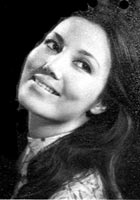
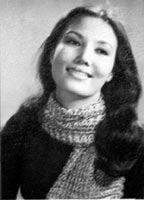
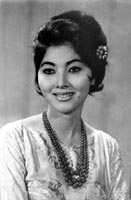
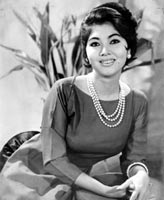
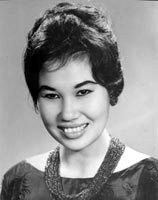
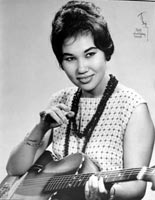
In 2007, the DVD of the Queen of the Theater, Thanh Nga, hit the Vietnamese market, and the public considered it to be a document of inestimable value regarding the unfortunate destiny of this late talented and elegant artist; the photographer Mau provided a loan of numerous images of Thanh Nga. He was somewhat saddened because they forgot to mention him in the credits and because the priceless photos were never returned!!
The artist Thanh Nga is but one of the people he photographed during his long artistic career, but nearly all were famous for a time, such as Tham Ham Thuy Hang, Bach Tuyet, Kim Cuong, Ngoc Giau, Thanh H. Thuy, Thanh Tuyen… and thanks to him they had photos for the magazines or to use as record jackets, or to give to admirers.
How many young portraits were made to provide emotional images? He thought of opening a photography studio for a living, to feed his family, to do business, but he formed relationships with the artists through barter. He told us many stories about these artists with his affectionate and emotional voice. About those who, returning from work in the evening, would invite him to eat late at night; these things were normal. This intimacy gave him insight to better understand his friends and to better bring them out in his photos and to make them more naturally beautiful.
His secret is that he understands each person better when photographed with his technical dexterity of light. Each has a different face; there are round faces, oval.
Portraits of singers of the sixties
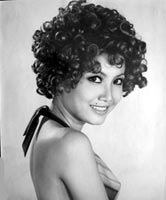
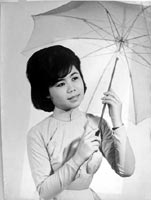
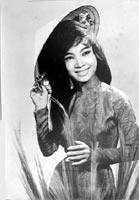
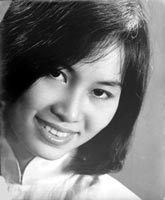
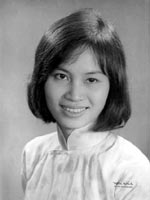
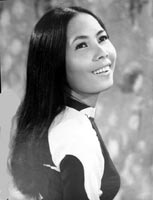
Looking at the images of artists he has preciously kept one understands that his artistic work is worth a few lessons to the younger generation. In the same way an artistic demeanor is created, down to the clothing, the facial makeup and the lighting, each image of an artist he makes is a synthesis of personal depth linked to a particularity of character. One could say that his body of work of the artists of Saigon is a collection of images of inestimable value to those who can appreciate it, as his history of the artists is a living source of insight into the life and times of artists who were famous for a while.
At the end of 1958 her took part in an exposition of artistic portraits and was awarded third prize. He was told of an exposition that would be dedicated to him, and he replied that he didn’t dare think of it because many other artists were more talented than he, but if there were to be a common exhibit he would happily participate. He hasn’t worked in ten years,
but when one speaks to him about it one sees his passion reborn…
Portraits of singers of the sixties
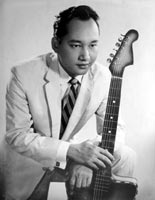
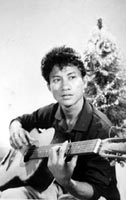
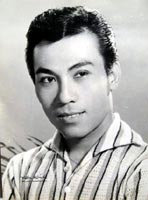
He has another passion, music. When he was still a photographer he collected cassettes and records. The artists used their photos for the jacket of their record or the sheet music of their song.
Because of this he had the pleasure of listening to new songs in preview before the records went on sale to the public. He kept many songs on his large and old tape recorder. He invited me for tea and to listen to the old songs…
Speaking of all sorts of things, he started a conversation about music and the poems that were adapted to it. He spoke of songs and of those musicians who were his friends, and was sorry so many of his precious records and tapes were lost during his moves. He recited from memory the entire poem Chua Hong (The Perfume Pagoda) by Nguyen Nhuoc Phap and spoke of the song adapted from the poem by Professor Tran Van Khe and commented on the manner in which the singer had styled it extravagantly, and told us that he listened to broadcasts of these songs for an hour every evening before going to bed.
We often spoke of our elders who were in the habit of re-living their past. In all these stories there are topics that the young people like myself cannot entirely understand because of the lack of insight through the thoughts of an experienced person.., but I can see them through the stories that bring to life many romantic images of the elegance and good mannerisms of the artists that he knew. How charming it is that we were able to share a bit of the beautiful life of the photographer who was named:
“He who captured the full youth of many of the artists of yesteryear”.
Lef : Photographer Mau at Dalat
Center: a South-Vietnamese actress
Right: his wife Pham Kin Binh on a Solex 2200
Pham Kin Binh, ViĂŞn Kinh Mau and Alphonse in 2009
 ÂMau's CitroĂ«n cars

